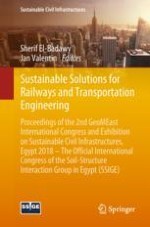This volume brings together scientific experts in different areas that contribute to the railway track and transportation engineering challenges, evaluate the state-of-the-art, identify the shortcomings and opportunities for research and promote the interaction with the industry. In particular, scientific topics that are addressed in this volume include railway ballasted track degradation/settlement problems and stabilization/reinforcement technologies, switches and crossings and related derailments causes, train-induced vibrations and mitigation measures, operations, management and performance of ground transportation, and traffic congestion and safety procedures. The volume is based on the best contributions to the 2nd GeoMEast International Congress and Exhibition on Sustainable Civil Infrastructures, Egypt 2018 – The official international congress of the Soil-Structure Interaction Group in Egypt (SSIGE).
